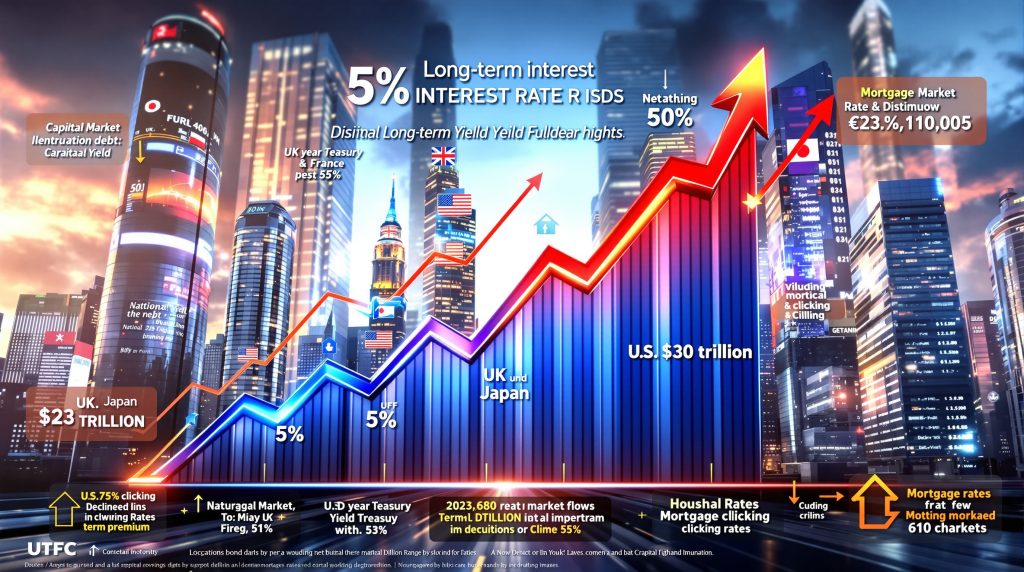Current Trends in Long-Term Interest Rates: Global Financial Implications
Long-term interest rates have been on a persistent upward trajectory across major economies, creating significant ripple effects throughout global financial markets. The U.S. 30-year Treasury yield has approached 5%, coming within 15 basis points of its highest level since 2007. This pattern extends beyond America—the United Kingdom's 30-year gilt yield has reached its highest point since 1998, while Japan's 30-year yield has hit record levels since its initial issuance in 1999. Similarly, France's 30-year yield has climbed to a 14-year high, according to recent Bank of England and Bank of Japan data.
These elevated rates represent a significant departure from the ultra-low interest environment that characterized the post-2008 financial crisis era. According to current projections from the Federal Reserve Economic Data (FRED), rising long-term interest rates are expected to remain elevated through 2025-2026, with consensus estimates suggesting U.S. rates may settle around 3.5% in 2025 and 2.7% in 2026.
The synchronized nature of this global rate increase suggests fundamental shifts in market dynamics rather than region-specific factors. This widespread pattern of rising yields has profound implications for economic growth, financial stability, and monetary policy effectiveness worldwide.
Historical Context and Recent Movements
When examining historical trends, today's rising rate environment marks a definitive end to the era of financial repression that dominated markets following the global financial crisis. Between 2009 and 2021, central banks maintained historically low interest rates and implemented massive asset purchase programs to stimulate economic growth.
Recent data from the U.S. Department of the Treasury shows the 10-year yield has fluctuated between 3.8% and 4.7% throughout 2024-2025, levels not consistently seen since before the 2008 financial crisis. This upward pressure on yields has occurred despite occasional economic uncertainty, suggesting structural rather than cyclical factors at work.
Why Are Long-Term Interest Rates Rising?
Fiscal Concerns and Government Debt
One of the primary drivers behind rising long-term rates is growing concern about fiscal sustainability. The U.S. fiscal deficit reached approximately $1.8 trillion in recent reporting periods according to the Congressional Budget Office (2024), contributing to a national debt that now exceeds $33 trillion based on U.S. Treasury data. This mounting debt burden has increased the term premium—the additional compensation investors demand for holding longer-term securities rather than rolling over short-term investments.
Economic analysis suggests that a one percentage point increase in the primary deficit correlates with an 11 basis point rise in the term premium. As government debt-to-GDP ratios have reached historically high levels outside of wartime or recession periods, markets are demanding higher yields to compensate for perceived long-term fiscal risks.
The composition of debt holders has also shifted significantly, with domestic holders now accounting for approximately 70% of total marketable U.S. debt, up from historical norms. This shift reduces reliance on foreign buyers but raises questions about market absorption capacity as issuance continues to increase, potentially contributing to US inflation and debt.
Economic Resilience and Growth Expectations
Contrary to earlier recession predictions, major economies have demonstrated unexpected resilience. The U.S. economy in particular has consistently outperformed expectations, with economic indicators frequently beating consensus forecasts. First-half economic growth for 2025 came in at approximately 1.25%, which, while modest, has reduced market expectations for aggressive monetary easing.
Employment data has been particularly robust, with recent non-farm payroll reports showing job additions significantly above consensus expectations. This labor market strength, combined with steady consumer spending, has reinforced market perceptions of economic durability despite higher borrowing costs.
The persistence of growth despite higher rates suggests structural changes in the economy's interest rate sensitivity, potentially reflecting technological innovation, business model adaptation, or changes in consumer behavior following the pandemic era. This resilience has also impacted the global recession outlook.
Central Bank Policies and Quantitative Tightening
Central banks' balance sheet reduction efforts have contributed significantly to the rate environment. Since initiating quantitative tightening in mid-2022, the Federal Reserve has reduced its securities holdings by over $2 trillion, bringing its balance sheet down to approximately $7.2 trillion according to recent Federal Reserve data.
This deliberate unwinding of pandemic-era stimulus has employed an adaptive strategy with monthly reduction caps, while simultaneously using tools like the Standing Repo Facility to manage liquidity when needed. This balancing act has created a complex environment where tighter monetary policy coexists with targeted interventions to maintain market stability.
The European Central Bank and Bank of England have pursued similar, if less aggressive, balance sheet reduction strategies, contributing to global upward pressure on yields. The synchronization of these policies marks a significant shift from the coordinated easing that characterized the post-2008 and pandemic response periods.
Shifting Inflation Expectations and Real Rate Dynamics
Analysis of yield curve movements reveals that rising real yields, rather than inflation expectations, account for much of the increase in nominal yields across most developed economies. This pattern suggests investors are demanding higher real returns, potentially reflecting concerns about long-term economic growth prospects or changes in the neutral rate of interest.
Financial economists have argued that the neutral rate (r-star)—the interest rate that neither stimulates nor restricts economic growth—has risen to approximately 3.5% in nominal terms, or 1.5% when adjusted for a 2% inflation target. This represents a significant increase from pre-pandemic assumptions and creates a higher floor for long-term rates.
The shift in real rate dynamics also reflects changing views on risk premia associated with duration exposure. As investors reassess the compensation required for taking interest rate risk over longer time horizons, the entire yield curve has shifted upward.
How Are Rising Long-Term Rates Affecting Financial Markets?
Bond Market Volatility and Structural Changes
The bond market has experienced significant volatility as investors adapt to the new rate environment. Government bond yields across developed economies have reached multi-year highs, creating challenges for fixed-income investors accustomed to the previous low-yield environment.
The elevated yield environment has prompted shifts in investor preferences, with increased demand for shorter-duration instruments to minimize interest rate risk. High-quality dividend-paying stocks have also gained attention as alternatives to traditional bond investments, particularly from income-focused investors.
Corporate bond markets present a mixed picture, with high-yield indices approaching 7%, creating potential for stronger returns but also heightened risks. Investment-grade corporate bonds have shown more resilience, though duration risk remains a significant concern for portfolio managers navigating this changing landscape.
Banking Sector Impacts
The banking sector faces both opportunities and challenges from rising long-term rates. While banks initially benefit from increased net interest income as rates rise, they eventually encounter headwinds from decelerating loan growth, increased funding costs, and decreased liquidity.
Recent banking sector analysis reveals that institutions with significant exposure to commercial real estate and long-term fixed-rate assets have faced particular pressures as their securities portfolios declined in value. Conversely, banks with more flexible asset-liability structures have benefited from improved net interest margins by repricing assets more quickly than liabilities.
The divergent experiences within the banking sector highlight the importance of effective asset-liability management and the risks associated with duration mismatches during periods of rapidly changing interest rates. The banking failures observed in early 2023 serve as stark reminders of the vulnerabilities that can emerge when interest rate risk is improperly managed.
Equity Market Differentiation
Rising long-term rates have created distinct winners and losers within equity markets. Sectors traditionally sensitive to interest rates, such as utilities and real estate, have experienced headwinds as investors reassess valuations in light of higher discount rates.
Technology and growth stocks have faced particular challenges, as higher long-term rates reduce the present value of future cash flows in valuation models. This dynamic has contributed to rotation toward value-oriented sectors with stronger current cash flows and lower duration profiles.
Financial sector stocks have generally benefited from the prospect of improved net interest margins, though this advantage must be balanced against potential credit quality concerns as economic conditions evolve. This sector-specific differentiation has important implications for portfolio construction and asset allocation strategies.
Commodity Market Dynamics
Commodity markets have shown interesting divergent performance in the rising rate environment. Traditionally, higher interest rates increase the opportunity cost of holding non-yielding assets like precious metals. However, gold prices analysis shows that gold and silver have demonstrated remarkable resilience, with gold reaching record highs despite rising real yields.
This apparent contradiction reflects several factors, including geopolitical uncertainty, central bank gold purchases, and concerns about long-term fiscal sustainability. Platinum has also attracted investor interest due to its significant discount to gold and its industrial applications in hybrid vehicles, which are gaining market share as the limitations of full electric vehicles become apparent.
Agricultural commodities like corn and soybeans have reached relatively attractive valuations, with corn trading around $4 per bushel and soybeans near $10—levels that may represent good entry points for investors with appropriate risk tolerance. Similarly, uranium continues to attract investment interest as nuclear power gains recognition as an essential component of low-carbon energy strategies.
What Are the Economic Consequences of Higher Long-Term Rates?
Housing Market Constraints
The housing market has been among the most severely affected sectors, with mortgage rates rising in tandem with long-term Treasury yields. The combination of elevated mortgage rates and high home prices has created significant affordability challenges, substantially reducing transaction volumes across many markets.
Sales of existing homes have fallen to near multi-decade lows in some regions, illustrating how elevated borrowing costs can effectively freeze activity in interest-sensitive sectors. This housing market slowdown has broader economic implications, potentially affecting construction activity, household wealth effects, and consumer confidence.
Regional variations in housing market impacts have been notable, with areas that experienced the most significant price appreciation during the pandemic era now facing more pronounced corrections. Markets with stronger underlying fundamentals, such as population growth and economic diversification, have shown greater resilience.
Corporate Investment and Capital Allocation
Higher long-term rates have forced corporations to reassess investment plans and capital allocation strategies. Companies with significant floating-rate debt have faced immediate increases in interest expenses, while those with predominantly fixed-rate financing have been insulated from direct impacts in the near term but face higher refinancing costs as debt matures.
The technology sector, which had become accustomed to low-cost financing for growth investments and acquisitions, has had to recalibrate expansion plans in light of higher discount rates. Manufacturing and industrial companies face dual pressures from higher financing costs and potential demand slowdowns as rate increases flow through to consumer and business spending patterns.
Corporate treasurers have adjusted liability management strategies, with many choosing to accelerate debt issuance during temporary yield declines to lock in relatively favorable rates. This opportunistic approach to debt management reflects recognition that the era of ultra-low financing costs may have permanently ended.
Government Fiscal Challenges
Rising long-term interest rates have significant implications for government finances, as higher borrowing costs increase debt servicing expenses. Interest payments on the U.S. national debt have grown substantially, creating budgetary pressures that could constrain fiscal flexibility in addressing future economic challenges.
The relationship between monetary and fiscal policy has become increasingly complex, with rising government debt levels creating challenges for both fiscal authorities and central banks. This dynamic raises fundamental questions about long-term fiscal sustainability and the potential need for structural reforms to address growing debt burdens.
As interest expenses consume a larger share of government budgets, political pressure may build to prioritize deficit reduction or to seek alternative financing mechanisms. The political economy of fiscal adjustment becomes increasingly challenging as debt servicing crowds out other spending priorities.
Consumer Spending and Household Balance Sheets
Consumer spending patterns have shown surprising resilience in the face of higher borrowing costs, though with important nuances across different segments. Higher-income consumers with substantial liquid assets and strong credit profiles have maintained spending, while those with higher debt burdens or limited financial flexibility have shown greater sensitivity to rising rates.
The distribution of household debt across fixed and variable rate instruments significantly affects the transmission of interest rate changes to household spending. Countries with predominantly variable-rate mortgage structures, such as the United Kingdom and Australia, have experienced more immediate impacts from rising rates than those with predominantly fixed-rate structures like the United States.
The significant buildup of household savings during the pandemic period has provided a buffer against rising rates for many consumers, though this effect has begun to fade as excess savings are depleted. Consumer credit metrics warrant close monitoring as the full effects of higher rates continue to work through the economy.
How Are Central Banks Responding to Rising Long-Term Rates?
Policy Rate Adjustments and Forward Guidance
Central banks face the complex challenge of balancing multiple competing objectives in the current environment. While short-term policy rates have been adjusted to address immediate economic conditions, the divergence between short-term and long-term rates has raised questions about the effectiveness of traditional monetary policy transmission mechanisms.
The Federal Reserve has signaled potential cuts in short-term rates while simultaneously managing the implications of rising long-term yields. This approach represents a "rate tweaking cycle rather than a rate cutting cycle," focused on calibrating policy to evolving economic conditions rather than embarking on a predetermined easing path.
Forward guidance has become increasingly nuanced, with central banks emphasizing data dependency and avoiding commitments to specific policy paths. This shift reflects recognition of the uncertainties surrounding inflation dynamics, growth trajectories, and the impact of previous policy actions.
Balance Sheet Management Strategies
Central banks' approach to balance sheet management has evolved to incorporate greater flexibility and responsiveness to market conditions. Reserve balances have been carefully monitored and adjusted to avoid over-tightening, particularly amid volatility in government accounts and potential liquidity pressures.
The Standing Repo Facility has played a crucial role in this strategy, allowing central banks to inject liquidity as needed while continuing broader balance sheet normalization efforts. This adaptive approach reflects recognition that balance sheet reduction must be carefully managed to avoid unintended disruptions in credit markets or broader financial stability concerns.
The composition of central bank balance sheets has also become a focus of policy discussions, with consideration of whether to target specific portions of the yield curve or maintain a more balanced approach across maturities. These decisions reflect evolving views on the transmission mechanisms of monetary policy and the appropriate role of central banks in financial markets.
International Coordination Challenges
International central bank coordination has become increasingly important as rising long-term rates create spillover effects across global financial markets. Different economic conditions and policy priorities across regions have created challenges for coordinated responses, with some central banks maintaining more accommodative stances while others focus on inflation containment.
This divergence in central bank policies has created complex cross-currency dynamics affecting international capital flows and exchange rate relationships. Emerging market economies have faced particular challenges as higher rates in developed markets have attracted capital flows away from riskier assets, while also increasing the cost of dollar-denominated debt.
The Bank for International Settlements has highlighted the importance of policy coordination to avoid adverse spillovers, though practical implementation remains challenging given different domestic mandates and economic conditions. This tension between domestic policy objectives and international considerations represents an ongoing challenge for central bankers.
What Are the Regional Variations in Long-Term Rate Impacts?
Developed Market Differentiation
Within developed markets, the impact of rising long-term rates has varied based on economic structures, debt levels, and policy responses. European markets have experienced similar upward pressure on long-term yields, though with important regional variations reflecting different fiscal positions and economic outlooks.
The United Kingdom has seen particularly pronounced rate increases, with 30-year gilt yields reaching multi-decade highs. Japan, despite maintaining its accommodative monetary policy stance longer than other major central banks, has also begun to experience upward pressure on long-term rates as global rate dynamics influence domestic markets.
Countries with higher government debt levels have generally experienced more significant yield increases, reflecting market concerns about fiscal sustainability. This pattern highlights the importance of fiscal fundamentals in determining market reactions to changing global financial conditions.
Emerging Market Vulnerabilities
Emerging markets have faced significant challenges from the global rise in long-term rates. Countries with substantial dollar-denominated debt have experienced increased borrowing costs and potential currency pressures as higher U.S. rates attract capital flows.
The magnitude of these effects has varied considerably based on individual country characteristics, with some emerging economies experiencing yield increases substantially larger than those seen in developed markets. Countries with stronger external positions, more credible policy frameworks, and lower reliance on external financing have demonstrated greater resilience.
Policy responses have varied across emerging markets, with some central banks maintaining higher policy rates to defend currencies and contain inflation, while others have attempted to shield domestic economies from external pressures. These divergent approaches reflect different assessments of vulnerabilities and policy priorities.
Domestic Regional Variations
Within the United States, the impact of rising long-term rates has shown important regional variations. Areas with economies heavily dependent on real estate development and construction have experienced more pronounced slowdowns as project financing has become more expensive and demand has weakened.
Conversely, regions with diversified economies and strong employment bases have demonstrated greater resilience, though none have been entirely immune to the effects of higher borrowing costs. These geographic differences have important implications for regional economic development and may influence future policy considerations at both federal and state levels.
Areas with higher concentrations of interest-sensitive industries have experienced more significant employment and growth impacts, highlighting the uneven transmission of monetary policy across regions and sectors. This heterogeneity creates challenges for policymakers seeking to address both national and regional economic objectives.
What Is the Future Outlook for Long-Term Interest Rates?
Consensus Projections and Uncertainty Ranges
Current projections suggest that long-term rates will gradually moderate from their recent peaks but remain elevated compared to the previous decade's ultra-low environment. Consensus estimates from the Survey of Professional Forecasters indicate U.S. rates may settle around 3.5% in 2025 and 2.7% in 2026, though with substantial uncertainty ranges reflecting the complex interplay of economic, political, and monetary factors.
These projections come with important caveats, as unexpected developments in fiscal policy, inflation dynamics, or global economic conditions could significantly alter the trajectory of long-term rates. The wide range of estimates from different forecasters—with projections for 2027 and beyond ranging from 2.4% to 4.9%—illustrates the substantial uncertainty surrounding long-term rate forecasts.
Financial market indicators, such as forward rate agreements and options markets, suggest continued volatility in rate expectations, with persistent risk premia for uncertainty about future rate paths. This market pricing reflects recognition of the multiple factors that could influence future rate trajectories.
Key Factors to Monitor
Several critical factors will shape the future path of long-term interest rates. Fiscal sustainability concerns will remain paramount, with government debt trajectories and deficit reduction efforts likely to significantly influence investor risk perceptions and required returns.
Inflation expectations and real rate dynamics will continue to play crucial roles, with particular attention to whether the recent rise in real yields represents a temporary phenomenon or a more fundamental shift in required returns. Central bank policy decisions, particularly regarding balance sheet management and the long-term neutral rate, will also significantly impact the rate environment.
Geopolitical developments and their implications for global trade, investment flows, and risk sentiment represent additional sources of uncertainty for long-term rate projections. These factors interact in complex ways, creating challenges for forecasting and policy formulation.
Potential Scenarios and Implications
Multiple scenarios could unfold for long-term interest rates, each with distinct implications for financial markets and economic activity. A gradual normalization scenario would see rates moderating toward long-term equilibrium levels, allowing for orderly adjustment across markets and sectors.
Alternatively, a more volatile scenario could emerge if fiscal concerns intensify or inflation expectations become unanchored, potentially leading to more pronounced rate increases and market disruptions. A third scenario might involve rates remaining persistently higher than pre-pandemic norms but stabilizing at levels that allow for economic adaptation over time.
Each of these scenarios carries different implications for investment strategies, economic growth prospects, and policy responses. The interaction between fiscal policy decisions, central bank actions, and market dynamics will ultimately determine which path materializes.
Investment Implications and Strategies
Investors navigating this uncertain rate environment face important strategic decisions. Fixed income strategies have shifted toward shorter durations to reduce interest rate risk, while also seeking opportunities in sectors with stronger credit fundamentals and floating-rate structures.
Equity market strategies have increasingly focused on valuation sensitivity to discount rates, favoring companies with strong current cash flows and pricing power. Sector allocation has become increasingly important, with careful consideration of how different businesses are affected by changing rate environments.
Alternative investments, including certain commodities and real assets, have attracted increased attention for their potential inflation-hedging characteristics and relative value in a higher rate environment. The relationship between tariffs and investment markets has also become an important consideration for portfolio positioning.
Navigating the New Long-Term Rate Environment
The persistent rise in long-term interest rates represents a fundamental shift in the global financial landscape, with far-reaching implications for investors, businesses, policymakers, and households. This transformation reflects complex interactions between fiscal sustainability concerns, changing economic growth expectations, central bank policies, and evolving investor risk perceptions.
The effects of higher long-term rates have manifested unevenly across sectors and regions, creating both challenges and opportunities depending on specific exposures and adaptability. Interest-sensitive sectors like housing have experienced significant constraints, while financial institutions with well-managed balance sheets have found opportunities in the changing rate environment.
For commodity investors, the current environment offers selective opportunities despite the traditional headwind of higher rates. Oil at $60-65 per barrel represents potential value when viewed in historical context, while agricultural commodities and certain metals have reached attractive valuations after periods of underperformance.
Looking ahead, the path of long-term rates will be shaped by critical developments in fiscal policy, inflation dynamics, and central bank approaches to balance sheet management. While consensus projections suggest a gradual moderation from recent peaks, substantial uncertainty remains about the ultimate equilibrium level for long-term rates in the post-pandemic economy.
For investors, businesses, and policymakers, successful navigation of this new environment will require flexibility, careful risk management, and recognition that the ultra-low rate era that characterized much of the past decade may have permanently ended. Adapting to this new reality presents challenges but also creates opportunities for those who can effectively recalibrate strategies for a world of higher long-term interest rates and identify promising investment opportunities 2025.
Disclaimer
This article contains general information and analysis of economic and market conditions. The views expressed are opinions as of the date of writing and are subject to change without notice. The information provided does not constitute investment advice and should not be relied upon as the basis for investment decisions. All investments involve risk, including the possible loss of principal. Past performance is not indicative of future results. Readers should consult with qualified financial professionals before making any investment decisions regarding the long-term interest rates.
Want to Identify Major Mineral Discoveries Before the Market?
Discover why significant mineral finds can generate substantial returns by exploring Discovery Alert's dedicated discoveries page, powered by the proprietary Discovery IQ model that turns complex mineral data into actionable insights. Begin your 30-day free trial today at https://discoveryalert.com.au/discoveries/ to position yourself ahead of the market.




